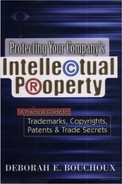The Test for Determining Trademark Infringement
The test used to determine whether one party's mark infringes that of another is whether the use is likely to cause confusion, mistake, or deception among the relevant consuming public. Actual confusion is not necessary; it is likelihood of confusion that is measured. The factors discussed in Chapter 4, used by the PTO in determining whether to allow a registration for a mark that is similar to another's, are the same as those used by courts in determining whether infringement has occurred. Furthermore, intent to infringe is not necessary. An innocent infringement is just as damaging to a trademark owner as an intentional one. Although the defendant's intent to infringe may play a role in assessing damages, there is no requirement that a defendant have intended to infringe another's mark.
Although different courts apply slightly different tests, and no one factor is determinative, in general the following factors are considered in determining trademark infringement:
Similarity of the marks as to their appearance, sound, connotation, and commercial impression. Marks need not be identical to infringe. In evaluating the similarities in marks, the emphasis is on the recollection of the average purchaser, who normally retains a general rather than specific impression of trademarks. Thus, SEYCOS used for watches was held likely to be confused with SEIKO® for watches, AQUA-CARE was held likely to be confused with WATERCARE® when both marks were used for water conditioning products, and RESPONSE was held likely to be confused with RESPONSE CARD® (with ''Card'' disclaimed) when both marks were used for banking services.
Similarity and nature of the goods and services offered under the marks. Goods and services need not be identical or even competitive for likelihood of confusion to exist. It is sufficient that the goods and services of the parties are related in some manner or that the circumstances surrounding their marketing are such that they are likely to be encountered by consumers who would have the mistaken belief that they originate from the same source. For example, CAREER IMAGES used for retail women's clothing store services and clothing was held likely to be confused with CREST CAREER IMAGES® for uniforms. On the other hand, LITTLE PLUMBER® for a liquid drain opener was held not confusingly similar to LITTLE PLUMBER® for advertising services because the goods and services were highly unrelated, although the marks were identical.
The similarity of the channels of trade for the goods or services. If goods offered under one mark are distributed only through retail and goods offered under the other mark are sold only to distributors, confusion may be reduced. Similarly, if goods bearing the marks are sold to different groups or advertised in different media, confusion is less likely.
The nature of the buyers for the goods. Marks for goods bought on impulse or marks used with inexpensive items generally are more readily confused than marks used for expensive goods. Consumers do not exercise great care when purchasing inexpensive items, so similar marks are more likely to infringe. On the other hand, when purchasing expensive items, consumers give a great deal of thought and consideration to their purchasing decisions, and confusion is less likely. In sum, marks for goods offered to sophisticated consumers who are knowledgeable about the products and services they purchase are less likely to be confused than marks used in connection with inexpensive items.
The relative strength and weakness of the marks. Strong marks are more easily infringed than weak, descriptive marks. Thus, numerous marks with tech or plus coexist, and consumers become adept at distinguishing between these numerous similar marks. Conversely, a strong coined mark such as XEROX® that has achieved wide fame and notoriety probably will be infringed by nearly any similar mark, no matter what goods or services are offered under the mark. Similarly, McDonald's has developed such a strong family of ''Mc'' marks that marks such as McPRETZEL, McRIB, and McDONUT have all been held confusingly similar to various McDonald's marks. In sum, strong marks are given broader protection than weak marks.
The existence of actual confusion. Actual confusion is not necessary to find infringement. The test is whether confusion is likely. Nevertheless, if actual confusion is shown, the junior mark is likely to be held to infringe the senior mark. If the marks have coexisted for a number of years and there has been no confusion, a court may well hold that no confusion is likely. Owners generally establish confusion by submitting testimony from consumers who state that they were confused (usually shown by complaint letters to the company) or by survey evidence. Consumers often are randomly selected and are presented with both marks. The survey results are then presented to court. Surveys often are challenged on the basis that they suffer from design or methodology flaws that compromise their results. Even if there is some actual confusion, infringement is not necessarily found. For example, in one case, a court found that there was no likelihood of confusion between SCOTT® for plastic and paper household goods and SCOTT'S LIQUID GOLD® for furniture polish because the products had coexisted for four years, and there were fewer than twenty instances of actual confusion, although fifty million cans of the furniture polish had been sold.[1]
[1] Scott Paper Co. v. Scott's Liquid Gold, 589 F.2d 1225 (3d Cir. 1978).
The defendant's intent. Although intent is not a necessary element in a trademark infringement case, if it can be shown that a defendant adopted a mark similar to the plaintiff's mark with the intention of deriving a benefit from the plaintiff's business reputation, this fact alone may be enough to justify the inference that there is confusing similarity.
